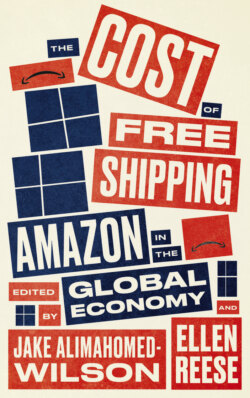Читать книгу The Cost of Free Shipping - Группа авторов - Страница 24
На сайте Литреса книга снята с продажи.
2 Power Accrues to the Powerful: Amazon’s Market Share, Customer Surveillance, and Internet Dominance Dana M. Williams
ОглавлениеAmazon’s corporate logo depicts a smile. Like other corporate brands, it is both wishful thinking and record-sanitizing. Google’s famous slogan “Don’t be evil” sought similar revisionism. In fact, tech giants like Amazon are not benevolent, smiling parts of our lives, but are central players in a state-corporate nexus. Such companies want to sell to us (and to profit from re-selling elements from our personal lives) and to enable governments to influence our lives. This state-corporate nexus is not new, but the modern era has seen its power taken to its logical, ominous conclusion. This chapter explores this by emphasizing an often-neglected side of Amazon: its incredible corporate power, web dominance, and surveillance of customers.
Amazon has accomplished much during its relatively short existence. Unfortunately, some of Amazon’s influence has been detrimental to workers, consumers, communities, and the environment. For example, by creating a “click consumerism” culture, Amazon has further facilitated the addictive lure of shopping, especially online. Thus, just as giant “big box” retail stores became the one-stop-shopping location that supplanted hardware, grocery, clothing, and electronics stores, Amazon.com makes it possible to do it all online. Amazon also has pioneered the mass collection of consumer data. While such data collection may seem innocent, it allows individuals to be unconsciously manipulated, exploited, and even preyed upon by the powerful actors who control the data. Every search and purchase by millions of users and customers is recorded by Amazon. The company uses this data to determine how to better market additional items. As an Amazon executive has stated, “In general, we collect as much information as possible.”1 An additional use of this user data is as a commodity itself to be sold to Amazon’s business clients. Amazon’s “Friends and Favorites” community requires validated profiles—replete with ample personal information, preferences, and behaviors—in order to be sold to other businesses for data-mining purposes.2 Amazon’s live-streaming platform Twitch is wholly about surveillance, which has been monetized in a political-economy of culture.3 All of this user-provided data is a valuable commodity. Shoshana Zuboff calls this “surveillance capitalism,” where consumers provide the raw materials: their own data, experiences, and preferences for the profit of tech corporations.4 Such “big data” could also be employed by governmental actors seeking to control democratic participation or protest. However, few customers likely read the fine print of Amazon user agreements and therefore remain ignorant of how their curiosities, preferences, and profiles are being used. Customers often presume corporate neutrality and simply don’t understand the power corporations like Amazon receive from user data.
This chapter explores how Amazon enriches itself through incredible corporate power, how Amazon has developed an impressive online data apparatus and made it available to corporate America and the government, and how Amazon has proliferated tools of mass self-surveillance among millions of customers. First, Amazon’s primary objective—making lots of profit—is pursued through strategies like monopolistic practices and increasing its market share, through political lobbying, tax avoidance, and vertical integration. Second, through Amazon’s pursuit of massive data collection, it created an impressive web-service infrastructure called Amazon Web Services (AWS), which is used by large portions of corporate America and state agencies (e.g., the CIA and ICE). This empowers such hierarchical organizations to wield incredible control over people. Finally, Amazon sells consumer tools that presumably offer conveniences, but in fact involve considerable compromises in security. These products expose people to privacy violations and other risks that the average customer does not understand.5
